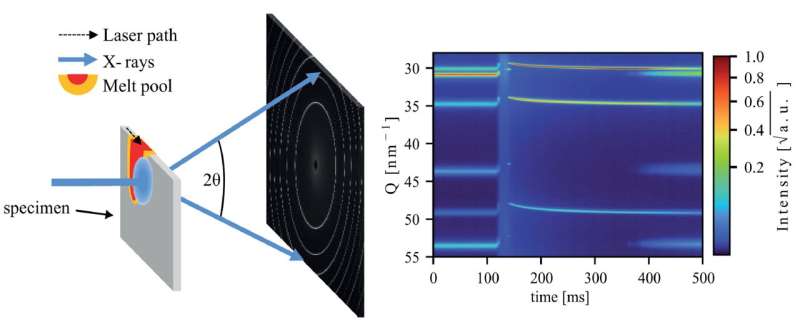This article has been reviewed according to Science X's editorial process and policies. Editors have highlighted the following attributes while ensuring the content's credibility:
fact-checked
peer-reviewed publication
trusted source
proofread
By cracking a metal 3D-printing conundrum, researchers propel the technology toward widespread application

Researchers have not yet gotten the additive manufacturing (or 3D printing) of metals down to a science completely. Gaps in our understanding of what happens within metal during the process have made results inconsistent. But a new breakthrough could grant an unprecedented level of mastery over metal 3D printing.
Using two different particle accelerator facilities, researchers at the National Institute of Standards and Technology (NIST), KTH Royal Institute of Technology in Sweden and other institutions have peered into the internal structure of steel as it was melted and then solidified during 3D printing. The findings, published in Acta Materialia, unlock a computational tool for 3D-printing professionals, offering them a greater ability to predict and control the characteristics of printed parts, potentially improving the technology's consistency and feasibility for large-scale manufacturing.
A common approach for printing metal pieces involves essentially welding pools of powdered metal with lasers, layer by layer, into a desired shape. During the first steps of printing with a metal alloy, wherein the material rapidly heats up and cools off, its atoms—which can be a smattering of different elements—pack into ordered, crystalline formations. The crystals determine the properties, such as toughness and corrosion resistance, of the printed part. Different crystal structures can emerge, each with their own pros and cons.
"Basically, if we can control the microstructure during the initial steps of the printing process, then we can obtain the desired crystals and, ultimately, determine the performance of additively manufactured parts," said NIST physicist Fan Zhang, a study co-author.
While the printing process wastes less material and can be used to produce more complicated shapes than traditional manufacturing methods, researchers have struggled to grasp how to steer metal toward particular kinds of crystals over others.
This lack of knowledge has led to less than desirable results, such as parts with complex shapes cracking prematurely thanks to their crystal structure.
"Among the thousands of alloys that are commonly manufactured, only a handful can be made using additive manufacturing," Zhang said.
Part of the challenge for scientists has been that solidification during metal 3D printing occurs in the blink of an eye.
To capture the high-speed phenomenon, the authors of the new study employed powerful X-rays generated by cyclic particle accelerators, called synchrotrons, at Argonne National Laboratory's Advanced Photon Source and the Paul Scherrer Institute's Swiss Light Source.
The team sought to learn how the cooling rates of metal, which can be controlled by laser power and movement settings, influence crystal structure. Then the researchers would compare the data to the predictions of a widely used computational model developed in the 1980s that describes the solidification of alloys.
While the model is trusted for traditional manufacturing processes, the jury has been out on its applicability in the unique context of 3D printing's rapid temperature shifts.
"Synchrotron experiments are time consuming and expensive, so you cannot run them for every condition that you're interested in. But they are very useful for validating models that you then can use to simulate the interesting conditions," said study co-author Greta Lindwall, an associate professor of materials science and engineering at KTH Royal Institute of Technology.
Within the synchrotrons, the authors set up additive manufacturing conditions for hot-work tool steel—a kind of metal used to make, as the name suggests, tools that can withstand high temperatures.
As lasers liquified the metal and different crystals emerged, X-ray beams probed the samples with enough energy and speed to produce images of the fleeting process. The team members required two separate facilities to support the cooling rates they wanted to test, which ranged from temperatures of tens of thousands to more than a million kelvins per second.
The data the researchers collected depicted the push and pull between two kinds of crystal structures, austenite and delta ferrite, the latter being associated with cracking in printed parts. As cooling rates surpassed 1.5 million kelvins (2.7 million degrees Fahrenheit) per second, austenite began to dominate its rival. This critical threshold lined up with what the model foretold.
"The model and the experimental data are nicely in agreement. When we saw the results, we were really excited," Zhang said.
The model has long been a reliable tool for materials design in traditional manufacturing, and now the 3D-printing space may be afforded the same support.
The results indicate that the model can inform scientists and engineers on what cooling rates to select for the early solidification steps of the printing process. That way the optimal crystal structure would appear within their desired material, making metal 3D printing less of a roll of the dice.
"If we have data, we can use it to validate the models. That's how you accelerate the widespread adoption of additive manufacturing for industrial use," Zhang said.
More information: Hans-Henrik König et al, Solidification modes during additive manufacturing of steel revealed by high-speed X-ray diffraction, Acta Materialia (2023). DOI: 10.1016/j.actamat.2023.118713
This story is republished courtesy of NIST. Read the original story here.




















